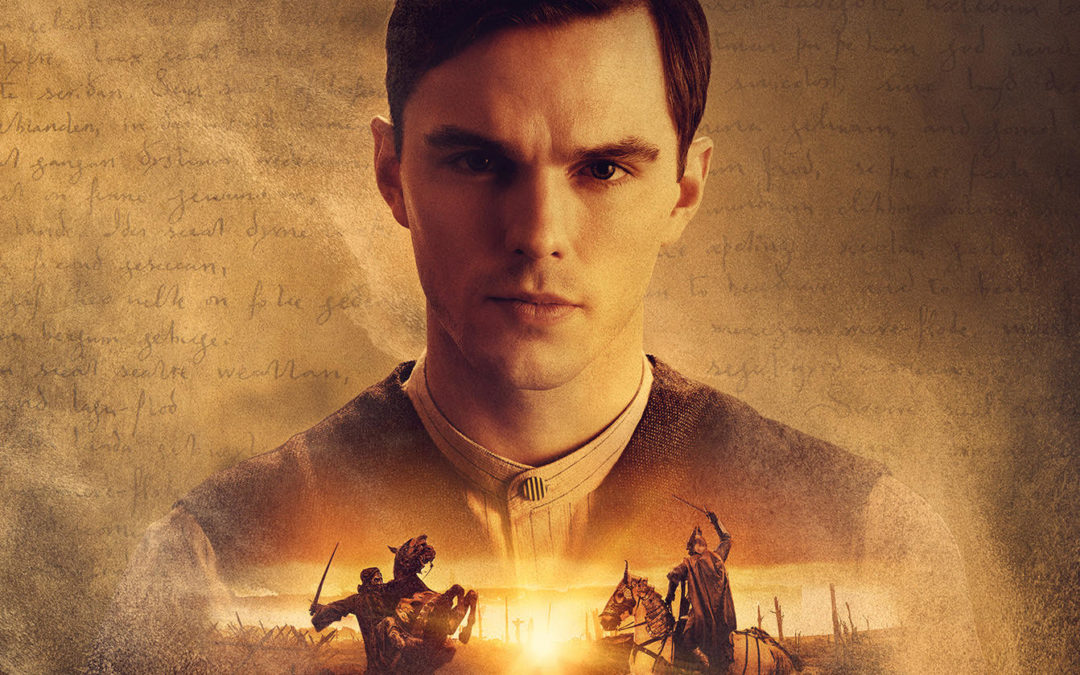Tolkien
Movie Review by Teri Hyrkas
Tolkien, the film is about the youthful years of English writer J.R.R. Tolkien, well known author of the Hobbit and The Lord of the Rings trilogy. It was released in the US in May, 2019. The screenplay was written by David Gleeson and Stephen Beresford and the movie was directed by award-winning Finnish director Dome Karukoski. It stars Nicholas Hoult as Tolkien and Lilly Collins as Edith Bratt, Tolkien’s boarding house sweetheart. According to Internet Movie Database (IMDb), Wikipedia and others, Tolkien bombed at the box office. The film cost approximately $20 million to make and has grossed only about $9 million as of the date of this writing. Rotten Tomatoes, a well known source for measuring the critical response of viewers to a given movie, assigned Tolkien a score of 51%… obviously not an “on-trend blockbuster.”
There were plenty of reviews that panned the movie. I think I can guess why critics and moviegoers might be inclined to disparage and be disappointed in Tolkien. The special effects and cinematography of director Peter Jackson’s film production of The Lord of the Rings (TLOTR) are so spectacular that they have become permanently embedded in the public consciousness. I believe Jackson’s movie scenes are inextricably linked to the author, Tolkien, because of the strong connection between Jackson’s movies and the books. Therefore, the very name “Tolkien” conjures up visions of TLOTR’s heart stopping special effects, phenomenal topographies and larger than life mythical creatures as created by Jackson.
By comparison, Karukoski’s Tolkien has only brief flashes and short, gauzy representations of fantasy-like moments and dragon-filled visions. Indeed, Karukoski’s most vivid, disturbing Jackson-esque scenes are related to Tolkien’s military service during World War I. In these, Tolkien – the young soldier – encounters the brutal actualities of modern warfare. Woven through these devastating war scenes, Karukoski has cinematically placed fleeting, dream-like images of demons and heroes. It was no surprise, then, to read the frequent objections made by reviewers of Tolkien which boiled down to, “It did not have the impact of a REAL movie. It is only a biopic — boring, banal and lacking in imagination.”
However, poor box office results and unreasonable disappointments of critics do not reflect on the quality of the moviemaking, the level of acting, or the value of the story portrayed in Tolkien, all of which I rate far above Rotten Tomatoes’ 51%. Rather than being about the extraordinary adventures of a Hobbit, Tolkien is a movie is about three kinds of love that J.R.R. Tolkien experienced in his young adulthood: Love of truly committed friends; love for a cherished soul mate; love of language and story.
The events of the film move through Tolkien’s young life and start from the “impecunious circumstances” which cause his widowed mother to move with her two young sons from a picturesque rural setting to an apartment in the industrial city of Birmingham – a dwelling found for them by Fr. Francis Morgan, a Catholic priest and friend of the family. Not long after the move, Tolkien’s mother dies. Fr. Francis, now the legal guardian of the Tolkien brothers, again provides aid by finding a benefactor who accepts the orphans into her boarding house. J.R.R. is then enrolled in King Edward’s School, where he excels as a student. King Edward’s is the location where Tolkien meets three young men who become his closest friends during his youth. The companions form what they call an “unbreakable alliance” that carries them through the years at King Edward’s School and on to university. This is the first love and “fellowship” of Tolkien’s young adult life.
It is at the boarding house that sixteen year-old Tolkien meets 19 year-old Edith Bratt, another orphan, and they fall in love. Their relationship is interrupted when J.R.R. fails to earn a scholarship to Oxford. Tolkien then grudgingly agrees to cooperate with Fr. Francis — who swore to Tolkien’s mother that he would see to it that her son went to university — and refrains from having any contact with Edith until he is twenty-one. J.R.R and Edith’s love for each other seems unlikely to survive the forced separation. Edith is the second love in Tolkien’s life and the challenge to their relationship is pivotal to the movie.
What about Tolkien’s calling as a writer? It is before the war as a student at Oxford that Karukoski depicts Tolkien as recognizing his third love — love of language and story. In 1913, after years of studying the classics, J.R.R. decides to change his major to English language and literature. This is clearly the correct course of study for him because in 1915 he graduates with first-class honors.
But it isn’t until twenty-two years later, in 1937, when he is a professor of English at Oxford, that Tolkien takes to heart a random line from a student’s paper and begins to write The Hobbit. An instant success, this book, according to the movie, fulfilled the pledge that the four young friends of the “unbreakable alliance” made to each other at King Edward’s School: “To change the world through the power of art.”
It is true that Tolkien is not an on-trend blockbuster movie, but it is also true that it is a beautifully rendered, well acted portrayal of the quiet,yet influential life of a beloved author and the integral part that love plays in helping him to use his art to change the world. As Christmas approaches, the season in which love Himself is born, Tolkien just might be the perfect movie to watch with your family.
Merry Christmas!


Thank you. I’m looking forward to seeing this movie.